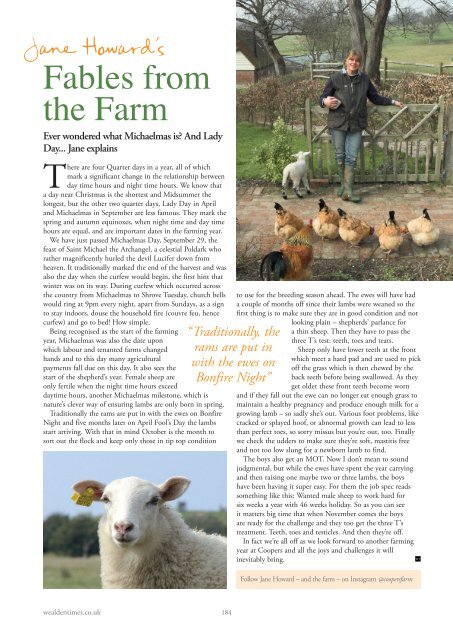Wealden Times | WT200 | October 2018 | Kitchen & Bathroom supplement inside
Wealden Times - The lifestyle magazine for the Weald
Wealden Times - The lifestyle magazine for the Weald
Create successful ePaper yourself
Turn your PDF publications into a flip-book with our unique Google optimized e-Paper software.
Jane Howard’s<br />
Fables from<br />
the Farm<br />
Ever wondered what Michaelmas is? And Lady<br />
Day... Jane explains<br />
There are four Quarter days in a year, all of which<br />
mark a significant change in the relationship between<br />
day time hours and night time hours. We know that<br />
a day near Christmas is the shortest and Midsummer the<br />
longest, but the other two quarter days, Lady Day in April<br />
and Michaelmas in September are less famous. They mark the<br />
spring and autumn equinoxes, when night time and day time<br />
hours are equal, and are important dates in the farming year.<br />
We have just passed Michaelmas Day, September 29, the<br />
feast of Saint Michael the Archangel, a celestial Poldark who<br />
rather magnificently hurled the devil Lucifer down from<br />
heaven. It traditionally marked the end of the harvest and was<br />
also the day when the curfew would begin, the first hint that<br />
winter was on its way. During curfew which occurred across<br />
the country from Michaelmas to Shrove Tuesday, church bells<br />
would ring at 9pm every night, apart from Sundays, as a sign<br />
to stay indoors, douse the household fire (couvre feu, hence<br />
curfew) and go to bed! How simple.<br />
Being recognised as the start of the farming<br />
year, Michaelmas was also the date upon<br />
which labour and tenanted farms changed<br />
hands and to this day many agricultural<br />
payments fall due on this day. It also sees the<br />
start of the shepherd’s year. Female sheep are<br />
only fertile when the night time hours exceed<br />
daytime hours, another Michaelmas milestone, which is<br />
nature’s clever way of ensuring lambs are only born in spring.<br />
Traditionally the rams are put in with the ewes on Bonfire<br />
Night and five months later on April Fool’s Day the lambs<br />
start arriving. With that in mind <strong>October</strong> is the month to<br />
sort out the flock and keep only those in tip top condition<br />
“Traditionally, the<br />
rams are put in<br />
with the ewes on<br />
Bonfire Night”<br />
to use for the breeding season ahead. The ewes will have had<br />
a couple of months off since their lambs were weaned so the<br />
first thing is to make sure they are in good condition and not<br />
looking plain – shepherds’ parlance for<br />
a thin sheep. Then they have to pass the<br />
three T’s test: teeth, toes and teats.<br />
Sheep only have lower teeth at the front<br />
which meet a hard pad and are used to pick<br />
off the grass which is then chewed by the<br />
back teeth before being swallowed. As they<br />
get older these front teeth become worn<br />
and if they fall out the ewe can no longer eat enough grass to<br />
maintain a healthy pregnancy and produce enough milk for a<br />
growing lamb – so sadly she’s out. Various foot problems, like<br />
cracked or splayed hoof, or abnormal growth can lead to less<br />
than perfect toes, so sorry missus but you’re out, too. Finally<br />
we check the udders to make sure they’re soft, mastitis free<br />
and not too low slung for a newborn lamb to find.<br />
The boys also get an MOT. Now I don’t mean to sound<br />
judgmental, but while the ewes have spent the year carrying<br />
and then raising one maybe two or three lambs, the boys<br />
have been having it super easy. For them the job spec reads<br />
something like this: Wanted male sheep to work hard for<br />
six weeks a year with 46 weeks holiday. So as you can see<br />
it matters big time that when November comes the boys<br />
are ready for the challenge and they too get the three T’s<br />
treatment. Teeth, toes and testicles. And then they’re off.<br />
In fact we’re all off as we look forward to another farming<br />
year at Coopers and all the joys and challenges it will<br />
inevitably bring.<br />
Follow Jane Howard – and the farm – on Instagram @coopersfarm<br />
wealdentimes.co.uk<br />
184


















